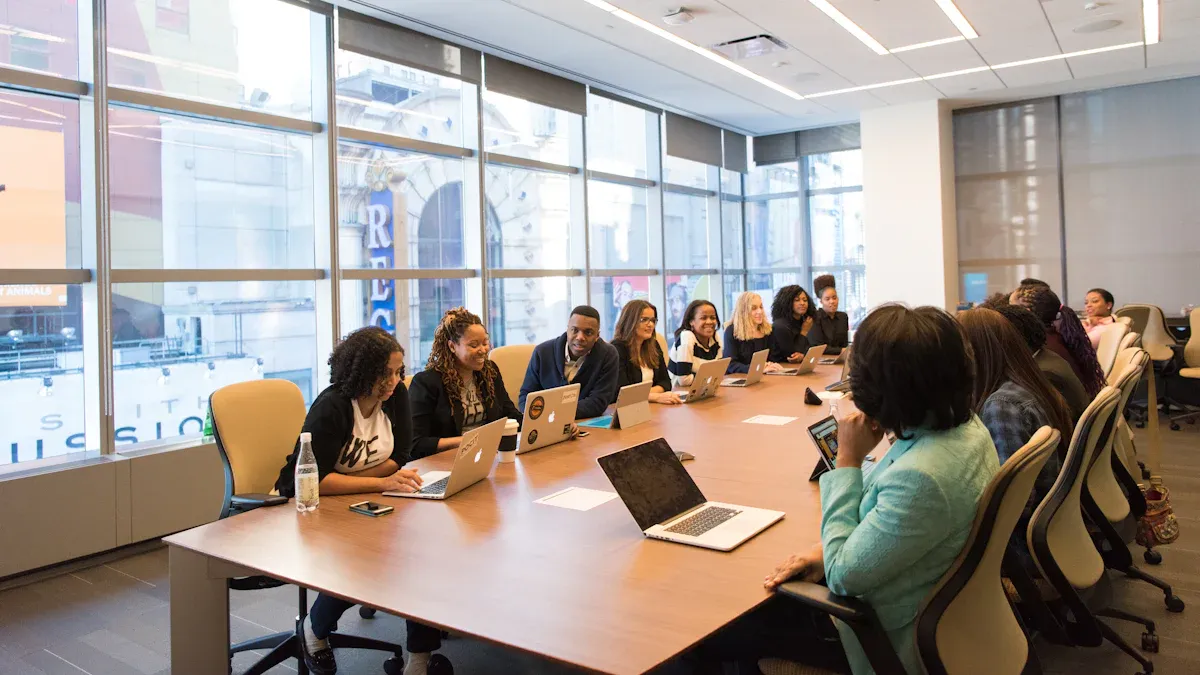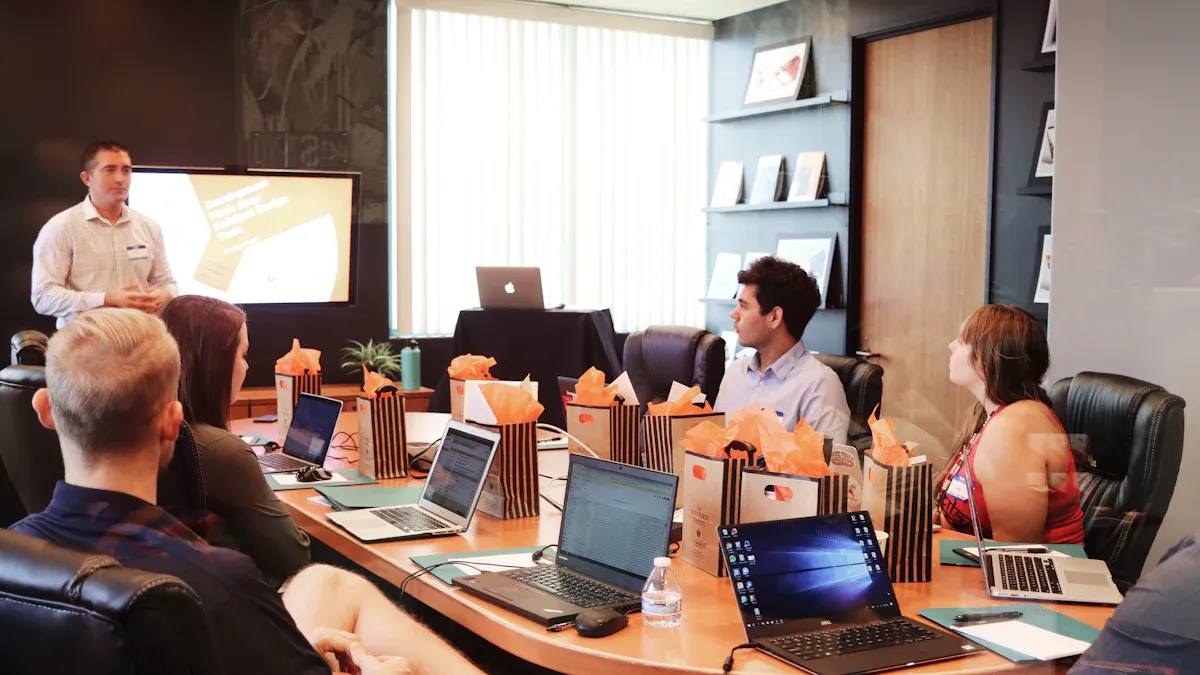Top Methods to Design Adaptive Employee Development Plans

In today’s fast-paced workplace, adaptive employee growth pathways have become essential. These pathways help you stay engaged and motivated by aligning your career goals with organizational needs. They also enable companies to thrive by fostering agility and adaptability.
Concept | Definition | Impact on Success Metrics |
|---|---|---|
Agility | Ability to swiftly respond to immediate challenges or opportunities. | Enhances productivity through quick decision-making. |
Adaptability | Capacity to evolve in response to long-term environmental shifts. | Drives revenue growth by aligning strategies with market changes. |
By linking career growth to organizational success, adaptive plans create a win-win scenario for both employees and employers.
Key Takeaways
Flexible growth plans match worker goals with company needs. This helps keep workers happy and loyal.
Check often for skill gaps to find training needs. This helps workers stay ready for new challenges.
Make learning plans personal by asking workers for ideas. Use different training styles to keep it fun and useful.
Support teamwork by using mentors and peer learning. This helps workers grow skills and enjoy their jobs more.
Leaders must help. Bosses should back these plans to inspire workers and build a learning culture.
Understanding Adaptive Employee Growth Pathways

Defining Adaptive Employee Growth Pathways
Adaptive employee growth pathways are structured yet flexible frameworks designed to align individual career aspirations with organizational goals. These pathways focus on tailoring development opportunities to meet the unique needs of each employee. By incorporating elements like mentorship, personalized training, and cross-functional experiences, they create a dynamic approach to career development.
Organizations such as City National Bank and Randstad have successfully implemented adaptive pathways. For instance, City National Bank supports its workforce through employee resource groups like the Black Colleague Alliance, which fosters mentorship and community engagement. Similarly, Randstad’s global mentoring program has significantly reduced turnover rates, showcasing the power of adaptive strategies in improving retention.
Benefits of Adaptive Employee Growth Pathways
Boosting Employee Engagement and Retention
Adaptive pathways enhance engagement by addressing individual career goals and providing meaningful growth opportunities. Employees feel valued when their aspirations align with the organization’s vision. This alignment leads to higher retention rates. For example, companies that adopt these pathways report up to a 51% reduction in turnover rates and a 45% increase in engagement scores.
Enhancing Organizational Adaptability and Innovation
A workforce equipped with diverse skills can adapt to changing market demands. Adaptive pathways encourage innovation by fostering cross-functional collaboration and continuous learning. Cruise Automation exemplifies this by pairing new hires with experienced mentors, enabling employees to develop skills that drive innovation.
Addressing Skill Gaps for Future Readiness
Closing skill gaps ensures your organization remains competitive. Adaptive pathways personalize training to individual needs, streamline learning, and scale programs to meet evolving demands. Conducting a skills gap analysis and leveraging data analytics can help refine these strategies. This approach not only prepares employees for future challenges but also strengthens organizational resilience.
Benefit | Measurement |
|---|---|
Increase in engagement scores | Up to 56% |
Higher productivity | Up to 17% higher |
Reduction in turnover rates | Up to 51% reduction |
Improvement in internal mobility | 56% improvement |
Key Strategies for Adaptive Career Pathing

Conducting Skill Gap Analysis
Identifying current and future skill needs
Understanding skill gaps is essential for adaptive career pathing. You can identify these gaps by evaluating current employee capabilities and comparing them to future organizational needs. Challenges often arise, such as the lack of specialized tools or the misconception that skill strategies are solely HR's responsibility. Involving department heads and leadership ensures a comprehensive approach.
Challenge | Description |
|---|---|
Missing specialized tools can limit the ability to proactively identify future skills or gaps. | |
Seeing skills-based talent strategies as the sole responsibility of HR | Success in transitioning to a skills-based approach requires involvement from various stakeholders beyond HR, including department heads and C-suite support. |
Leveraging data-driven tools for precision
Data-driven tools streamline skill gap analysis. Use training assessments, post-training feedback surveys, and performance metrics to evaluate skill improvements. Tools like 15Five and Reflektive help collect and analyze employee feedback. Self-assessment surveys and 360-degree assessments also provide valuable insights. These methods ensure precision in identifying and addressing skill gaps.
Designing Personalized Learning Paths
Incorporating employee input and career goals
Personalized learning thrives on employee input. Encourage self-assessments to help employees reflect on their strengths and aspirations. One-on-one meetings allow you to align learning paths with career goals. Collecting feedback from employees and managers ensures these paths remain relevant and effective.
Providing diverse learning formats and resources
Diverse learning formats cater to different preferences, making personalized learning more effective. Options include eLearning modules, webinars, classroom-style sessions, and on-the-job training. Group discussions and problem-solving activities also enhance engagement. Offering varied formats ensures employees can access learning opportunities that suit their needs.
Implementing Flexible Career Pathing
Encouraging cross-functional and lateral moves
Cross-functional and lateral moves expand employee networks and reduce burnout. They also foster innovation and improve talent retention. Employees gain new skills and build relationships without leaving the organization. Studies show that 94% of employees would stay longer at companies investing in their career growth.
Supporting vertical career progression
Vertical career progression requires structured support. Establish fair promotion policies and provide career coaching. Equip employees with tools for self-assessment and planning. Align career moves with strategic goals to address skill gaps and build succession pipelines. Clear communication and training ensure smooth transitions for newly promoted employees.
Integrating Learning into Workflows
Embedding microlearning and on-the-job training
Embedding learning into daily workflows ensures employees can develop skills without disrupting their routines. Microlearning, which delivers short and focused content, works best when integrated into tools employees already use.
Use mobile-friendly platforms to make learning accessible on the go.
Embed learning resources into systems like Learning Management Systems (LMS) or collaboration tools.
For a seamless experience, prioritize microlearning by keeping content concise and relevant. AI-powered platforms can recommend personalized resources, while tools like Slack or Microsoft Teams encourage knowledge sharing. For example, embedding training modules in core applications allows employees to learn while completing tasks. This approach makes workplace learning more efficient and engaging.
Promoting mentorship and peer learning
Mentorship and peer learning foster collaboration and skill development. Employees benefit from guidance, while mentors enhance their leadership skills. Studies show that 72% of mentees and 69% of mentors stay with their organizations, compared to 49% of non-participants. Additionally, 9 out of 10 workers with mentors report job satisfaction.
Benefit Type | Impact |
|---|---|
Retention Rates | Higher retention among mentees and mentors. |
Job Satisfaction | Over half of mentored employees feel "very satisfied" with their jobs. |
Organizational Performance | 67% of HR professionals believe mentoring boosts performance. |
Encourage mentorship programs to build a culture of learning. Peer learning sessions, where employees share insights, also strengthen team bonds and promote innovation.
Aligning Career Development with Organizational Goals
Connecting individual growth to business objectives
Aligning career development with organizational goals ensures mutual success. Communicate growth projections and strategic initiatives to help employees understand potential career paths. Use the "3 E’s model"—Education, Exposure, and Experience—to shape development plans. For example, enroll employees in relevant courses, provide mentorship opportunities, and assign leadership roles in projects.
Regular check-ins allow you to discuss progress and provide feedback. This ensures employees’ goals align with business needs. Setting clear KPIs also helps measure success and incentivizes goal completion.
Regularly updating plans to reflect evolving priorities
Career development plans should evolve with organizational needs. Update these plans every 12-18 months to stay adaptable. This frequency allows you to respond to changing priorities effectively. Regular updates also ensure employees remain aligned with the company’s direction, fostering long-term growth and resilience.
Best Practices for Implementation
Leadership Involvement in Adaptive Career Pathing
Securing executive support for development initiatives
Strong leadership involvement is essential for adaptive career pathing. Executives play a pivotal role in shaping flexible career paths that align with individual strengths and organizational goals. They should ensure transparency in internal growth opportunities, which motivates employees to pursue career advancement within the organization. Regular feedback sessions with employees help leaders understand their aspirations and provide tailored career support.
To foster success, leaders must invest in training programs for both managers and employees. These programs enhance guidance and skill-building, creating a workforce ready to adapt to change. Additionally, a transparent framework outlining role requirements reduces frustration and clarifies progression paths. Leaders who link career growth to organizational success inspire motivation and retention.
Encouraging managers to champion employee growth
Managers act as catalysts for professional development. Training managers on engagement factors equips them to better support their teams. Incorporating career management into management training ensures they prioritize employee education and growth. Mentorship programs further strengthen this dynamic by fostering collaboration and skill-sharing.
Managers should also facilitate career mapping and planning. This approach enhances job satisfaction and ensures employees feel supported in their career journeys. Continuous skills training tailored to individual needs empowers employees to thrive in their roles and contribute to organizational success.
Building a Culture of Adaptability
Promoting continuous learning and innovation
A culture of adaptability thrives on continuous learning and development. Encourage employees to acquire new skills relevant to their roles and the organization’s goals. Leadership must actively endorse learning initiatives, setting an example for the workforce. Identifying skill gaps and tailoring training programs to address them ensures employees remain competitive.
Recognizing employees’ efforts in learning and development fosters motivation. Public praise, incentives for completing training, and advancement opportunities based on new skills create a positive feedback loop. This approach not only enhances individual growth but also drives innovation across the organization.
Recognizing and rewarding adaptability
Acknowledging adaptability strengthens employee engagement. Leaders should celebrate employees’ ability to embrace change and learn continuously. Structured change management practices minimize disruption and create a responsive environment. Flexible working arrangements empower employees to adapt to evolving demands.
Public recognition, such as highlighting achievements during team meetings, reinforces the value of adaptability. Incentives like bonuses or promotions for acquiring new skills further encourage employees to embrace change. These strategies build a resilient workforce ready to tackle challenges.
Using Feedback to Refine Development Plans
Conducting regular performance reviews and check-ins
Performance reviews are vital for refining development plans. Set clear, actionable goals aligned with business objectives to guide employees. Regular check-ins track progress and address challenges, ensuring goals remain relevant. Collaborate with employees to create individual development plans that support their career aspirations.
Formal appraisals provide clarity on strengths and areas for improvement. Recognizing outstanding performance during these reviews keeps employees motivated. Revisiting development plans during one-on-one meetings ensures they stay on track and receive the necessary support.
Leveraging feedback to improve pathways
Employee feedback is a powerful tool for enhancing adaptive career pathing. Regular coaching sessions and feedback loops help employees navigate their career paths effectively. Structured opportunities for learning and practicing new skills ensure continuous growth.
Make internal growth opportunities visible to employees. This transparency helps them align their career goals with organizational needs. By incorporating feedback into career support strategies, you can create pathways that are both adaptive and effective.
Adaptive employee growth pathways are essential for fostering a thriving workplace. They align individual aspirations with organizational goals, driving engagement and retention. Companies with robust development programs report up to a 56% increase in engagement scores and a 50% reduction in attrition.
To implement these pathways effectively:
Conduct regular career conversations to understand aspirations.
Build personalized development plans.
The long-term benefits are undeniable. Organizations experience up to 17% higher productivity, $52 million in annual savings, and enhanced innovation. Investing in adaptive plans ensures success for both employees and businesses.
FAQ
What are adaptive employee development plans?
Adaptive employee development plans are personalized frameworks that align your career goals with organizational objectives. These plans focus on flexibility, skill-building, and continuous learning to help you grow professionally while meeting business needs.
How can you identify skill gaps effectively?
You can identify skill gaps by conducting self-assessments, using data-driven tools, and analyzing performance metrics. Collaborate with managers and team leaders to ensure a comprehensive evaluation of current and future skill requirements.
Why is mentorship important in adaptive career pathing?
Mentorship fosters collaboration and skill-sharing. It helps you gain valuable insights from experienced professionals. Mentors also enhance their leadership skills, creating a win-win situation. Studies show mentorship improves retention and job satisfaction.
How do flexible career paths benefit employees?
Flexible career paths let you explore cross-functional roles or lateral moves. This approach broadens your skill set, reduces burnout, and increases engagement. It also supports vertical growth by providing structured opportunities for promotions and leadership roles.
What role does leadership play in adaptive development plans?
Leadership drives the success of adaptive plans. Leaders provide guidance, ensure transparency, and align career growth with business goals. Their involvement motivates you to pursue development opportunities and fosters a culture of continuous learning.
See Also
Enhancing Team Productivity With Effective Talent Management Tools
Improving Employee Satisfaction With MokaHR’s Management Solutions
Transforming Hiring Processes Using MokaHR’s Advanced Recruitment Tools
A Fresh Perspective On Recruitment: Advantages Of MokaHR
Efficient Strategies Within MokaHR’s Recruitment Management Framework
From recruiting candidates to onboarding new team members, MokaHR gives your company everything you need to be great at hiring.
Subscribe for more information

